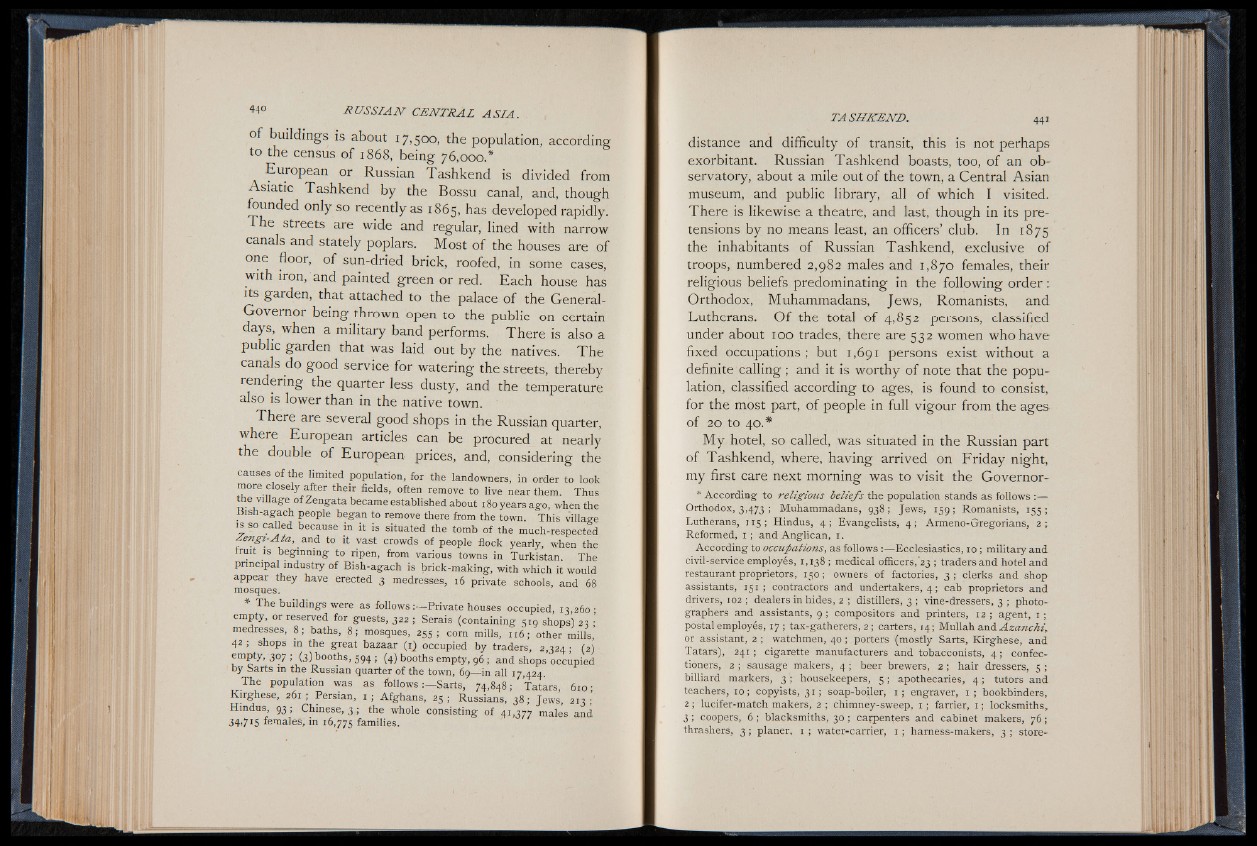
of buildings is about 17,500, the population, according
to the census of 1868, being 76,000.*
European or Russian Tashkend is divided from
Asiatic Tashkend by the Bossu canal, and, though
founded only so recently as 1865, has developed rapidly.
The streets are wide and regular, lined with narrow
canals and stately poplars. Most of the houses are of
one floor, of sun-dried brick, roofed, in some cases,
with iron, and painted green or red. Each house has
its garden, that attached to the palace of the General-
Governor being thrown open to the public on certain
days, when a military band performs. There is also a
public garden that was laid out by the natives. The
canals do good service for watering the streets, thereby
rendering the quarter less dusty, and the temperature
also is lower than in the native town.
There are several good shops in the Russian quarter,
where European articles can be procured at nearly
the double of European prices, and, considering the
causes of the limited population, for the landowners, in order to look
more closely after their fields, often remove to live near them. Thus
the village ofZengatabecameestablishedabout 180 years ago, when the
Bish-agach people began to remove there from the town. This village
is so called because in it is situated the tomb of the much-respected
¿engi-Ata, and to it vast crowds of people flock yearly, when the
fruit is beginning to ripen, from various towns in Turkistan. The
principal industry of Bish-agach is brick-making, with which it would
appear they have erected 3 medresses, 16 private schools, and 68
mosques.
* The buildings were as follows :— Private houses occupied 13 260 •
empty, or reserved for guests, 322 ; Serais (containing 510 shops) 23 •
medresses, 8; baths, 8; mosques, 255; com mills, 116; other mills’
42 ; shops m the great bazaar (1) occupied by traders, 2,324; (2)
empty, 307 ; (3) booths, 594 ; (4) booths empty, 96; and shops occupied
by Sarts in the Russian quarter of the town, 69— in all 17,424.
The population was as f o l lo w s S a r t s , 74,848; Tatars, 610;
Kirghese, 261; Persian, 1 ; Afghans, 25; Russians, 38; Jews, 213;
Hindus, 93; Chinese, 3 ; the whole consisting of 41,377 males and
34>7J5 females, in 16,775 families.
distance and difficulty of transit, this is not perhaps
exorbitant. Russian Tashkend boasts, too, of an observatory,
about a mile out of the town, a Central Asian
museum, and public library, all of which I visited.
There is likewise a theatre, and last, though in its pretensions
by no means least, an officers’ club. In 1875
the inhabitants of Russian Tashkend, exclusive of
troops, numbered 2,982 males and 1,870 females, their
religious beliefs predominating in the following order :
Orthodox, Muhammadans, Jews, Romanists, and
Lutherans. O f the total of 4,852 persons, classified
under about 100 trades, there are 532 women who have
fixed occupations ; but 1,691 persons exist without a
definite calling ; and it is worthy of note that the population,
classified according to ages, is found to consist,
for the most part, of people in full vigour from the ages
of 20 to 40.*
My hotel, so called, was situated in the Russian part
of Tashkend, where, having arrived on Friday night,
my first care next morning was to visit the Governor-
* According to religious beliefs the population stands as follows :—
Orthodox, 3,473 ; Muhammadans, 938; Jews, 159; Romanists, 155 ;
Lutherans, 1 15 ; Hindus, 4 ; Evangelists, 4 ; Armeno-Gregorians, 2 ;
Reformed, 1 ; and Anglican, 1.
According to occupations, as follows :— Ecclesiastics, 10 ; military and
civil-service employés, 1,138 ; medical officers,’23 ; traders and hotel and
restaurant proprietors, 150; owners of factories, 3 ; clerks and shop
assistants, 151 ; contractors and undertakers, 4; cab proprietors and
drivers, 102 ; dealers in hides, 2 ; distillers, 3 ; vine-dressers, 3 ; photographers
and assistants, 9 ; compositors and printers, 12 ; agent, 1 ;
postal employés, 17; tax-gatherers, 2 ; carters, 14; Mullah and Azanchi,
or assistant, 2 ; watchmen, 40 ; porters (mostly Sarts, Kirghese, and
Tatars), 241 ; cigarette manufacturers and tobacconists, 4 ; confectioners,
2 ; sausage makers, 4 ; beer brewers, 2 ; hair dressers, 5 ;
billiard markers, 3 ; housekeepers, 5 ; apothecaries, 4 ; tutors and
teachers, 10; copyists, 3 1 ; soap-boiler, 1 ; engraver, 1 ; bookbinders,
2 ; lucifer-match makers, 2 ; chimney-sweep, 1 ; farrier, 1 ; locksmiths,
3 ; coopers, 6 ; blacksmiths, 30 ; carpenters and cabinet makers, 76 ;
thrashers, 3 ; planer, 1 ; water-carrier, 1 ; hamess-makers, 3 ; store